Home Decor
How to Use Lighting to Enhance Your Interior Decor!
Keen to transform your space? Discover how strategic lighting choices can elevate your decor and create the perfect ambiance!
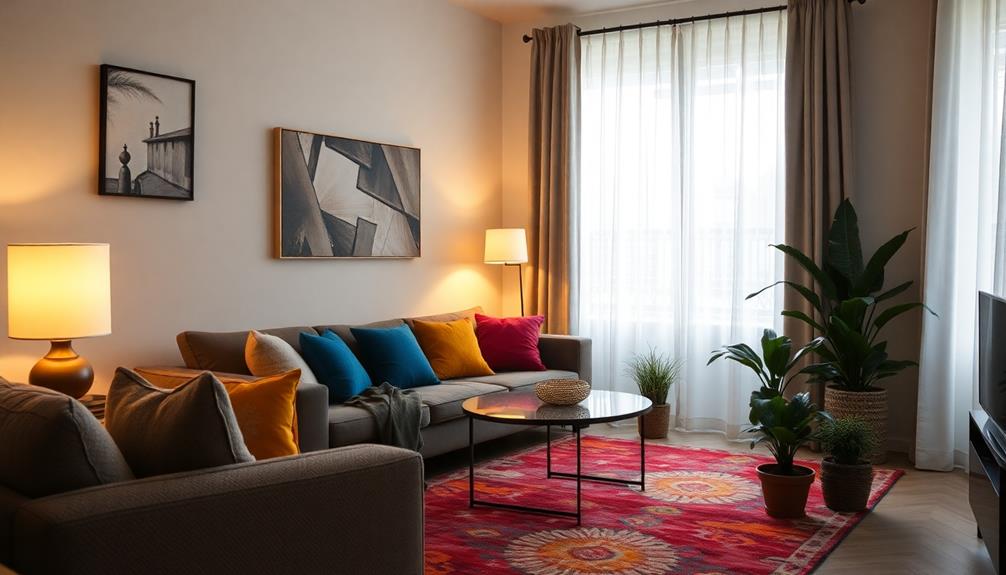
To enhance your interior decor with lighting, start by layering ambient, task, and accent lighting for a well-balanced atmosphere. Use ambient lighting for an overall glow, task lighting for specific activities, and accent lighting to highlight artwork or architectural features. Consider the room's purpose; bright task lights work well in the kitchen, while soft, warm lights create a cozy vibe in the bedroom. Don't forget to personalize with unique fixtures and dimmers to set the mood. By making thoughtful lighting choices, you can dramatically transform your space into a reflection of your style and comfort. Explore more ideas to elevate your decor! Consider incorporating unique fixtures inspired by Balinese style decor ideas to add a touch of exotic flair to your interior. Look for ornate pendants or lanterns, intricate sconces, and colorful mosaic lamps to bring a sense of warmth and luxury to your space. By combining these elements with the right balance of ambient, task, and accent lighting, you can create a truly stunning and inviting atmosphere that reflects your individual style and personality.
Key Takeaways
- Layer ambient, task, and accent lighting to create a well-balanced atmosphere that enhances room functionality and aesthetics.
- Use warm color temperatures (2700-3000K) for cozy spaces, and cooler temperatures (4000-6500K) to promote alertness in work areas.
- Strategically place fixtures to highlight architectural features, artwork, or focal points, adding depth and visual interest to your decor.
- Incorporate statement lighting to create striking focal points that express your personal style and enhance the overall design narrative.
- Utilize dimmers to customize light intensity, allowing for mood adjustments and versatility in different settings throughout your home.
Importance of Lighting in Design

Lighting plays an essential role in design, shaping the mood and aesthetics of any space. You mightn't realize it, but the significance of lighting goes far beyond mere visibility. Proper lighting can enhance the perception of room size, making smaller areas feel more expansive and inviting.
In Balinese interior design, for instance, the use of natural light is key for creating an inviting ambiance that promotes tranquility and relaxation. By implementing effective lighting solutions, you create a warm and welcoming atmosphere that draws people in.
A well-thought-out lighting design incorporates ambient lighting, task lighting, and accent lighting, each serving a unique purpose. Ambient lighting provides the general illumination necessary for everyday activities, while task lighting focuses on specific areas, like a reading nook or kitchen counter. Accent lighting highlights architectural features and wall decorations, injecting character and depth into your interior decor.
You can enhance this effect by integrating natural elements, such as natural materials and patterns, which align beautifully with the overall design.
Layering light is important for achieving a cohesive design. By mixing different types of lighting, you can work in harmony with color, texture, and furniture, creating a balanced environment.
Whether you're updating a single room or your entire home, remember that quality lighting is key for elevating your space and enhancing its overall appeal. So, take the time to reflect on how lighting can transform your interior decor into something truly special.
Types of Lighting Explained
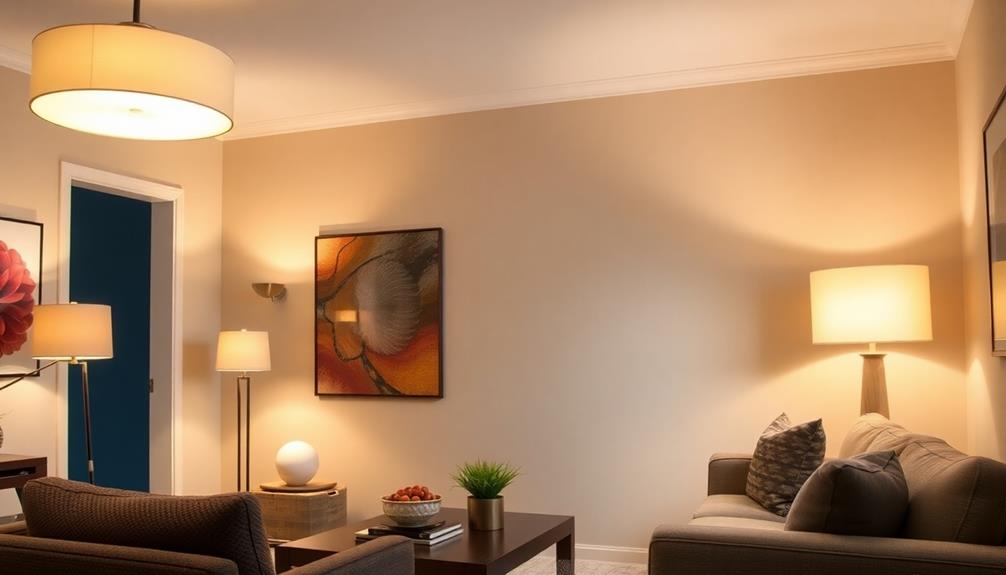
When it comes to interior decor, understanding the different types of lighting is crucial for creating an inviting and functional space. The three main types—ambient, task, and accent lighting—each serve a unique purpose in your lighting plan.
Ambient lighting acts as the foundational layer, providing a soft, even glow throughout the room. This type of lighting sets the overall mood, making it feel warm and inviting. To enhance this warmth, consider incorporating Scandinavian charm in kid-friendly homes with light colors and natural materials.
Task lighting, on the other hand, focuses on specific areas where you need more illumination to perform activities like reading, cooking, or studying. It guarantees safety and efficiency during these tasks.
Lastly, accent lighting adds visual interest by highlighting particular features or objects in your space, such as artwork or architectural details. This type creates depth and drama in your decor.
To achieve a well-balanced atmosphere, you should combine these three types effectively. For instance, using warm light (2700-3000K) in living areas can enhance coziness, while cooler white light (4000-6500K) is perfect for workspaces to encourage alertness.
Room-Specific Lighting Tips

Creating a well-lit environment requires tailored approaches for each room in your home. By understanding the specific needs of each space, you can effectively enhance your interior design through thoughtful lighting choices.
| Room | Lighting Tips |
|---|---|
| Living Room | Use a mix of ambient, task, and accent lighting. Floor lamps in corners and table lamps on sideboards can boost the overall ambiance. |
| Kitchen | Focus on task lighting, like under-cabinet lights, for cooking. Incorporate accent lighting to highlight backsplashes or artwork. |
| Bedroom | Aim for calming, warm ambient lighting. Add task lighting by reading areas and use accent lighting to create a soothing atmosphere. |
In bathrooms, install task lighting around mirrors for grooming, while ambient lighting promotes relaxation. Accent lighting can showcase architectural features. Remember, each room's lighting should be tailored to its specific function, ensuring that all areas are effectively illuminated and visually appealing. With the right combination of ambient, task, and accent lighting, you can transform your home into a beautifully lit sanctuary.
Recommended Lighting Products
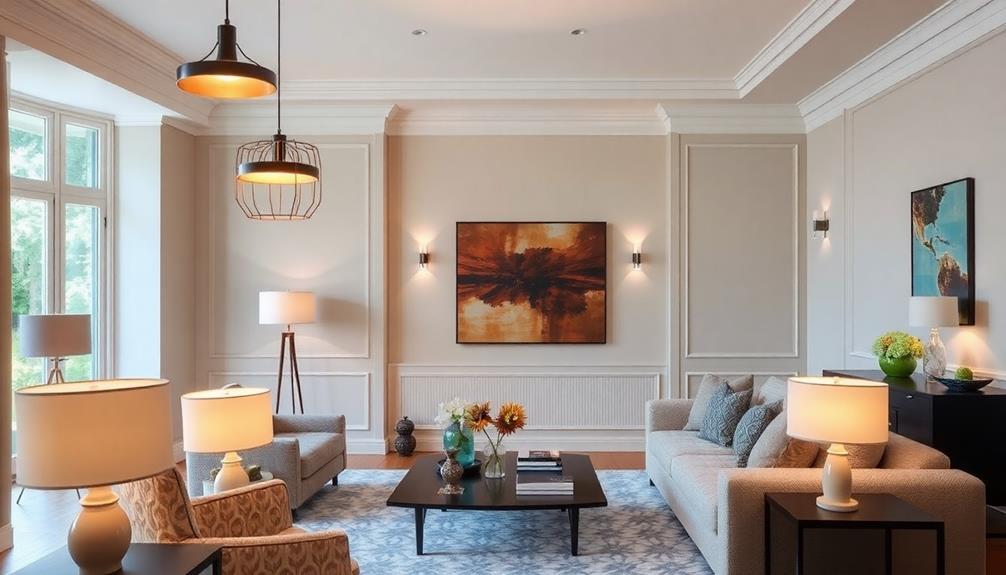
Choosing the right lighting products can greatly enhance your home's atmosphere and functionality. Thoughtful lighting design can also support smart home theater design for an immersive viewing experience.
Consider incorporating the Louis Poulsen AJ 50 LED Outdoor Wall Lamp for stylish wall lights that elevate your exterior while providing essential illumination.
Inside, the Mater Terho Pendant brings a cozy touch, perfect for creating warm ambiance in dining or living areas with its inviting design.
For versatility, the GUS Modern Lightbox 2 serves as an excellent choice for both accent lighting and ambient lighting, effortlessly fitting into various decor styles.
If you need focused illumination, the NYTA Tilt Globe Pendant is ideal for task lighting, easily adjustable to shine light on kitchens or reading nooks.
Additionally, the Ferm Living Collect Lighting Series offers customizable mix-and-match options, allowing you to tailor the lighting types to reflect your personal style and needs.
Whether you opt for pendant lights, table lamps, or wall lights, these products can transform any space into a well-lit, inviting environment.
Make thoughtful selections, and you'll see how the right lighting can breathe life into your home's decor.
Leading Lighting Brands
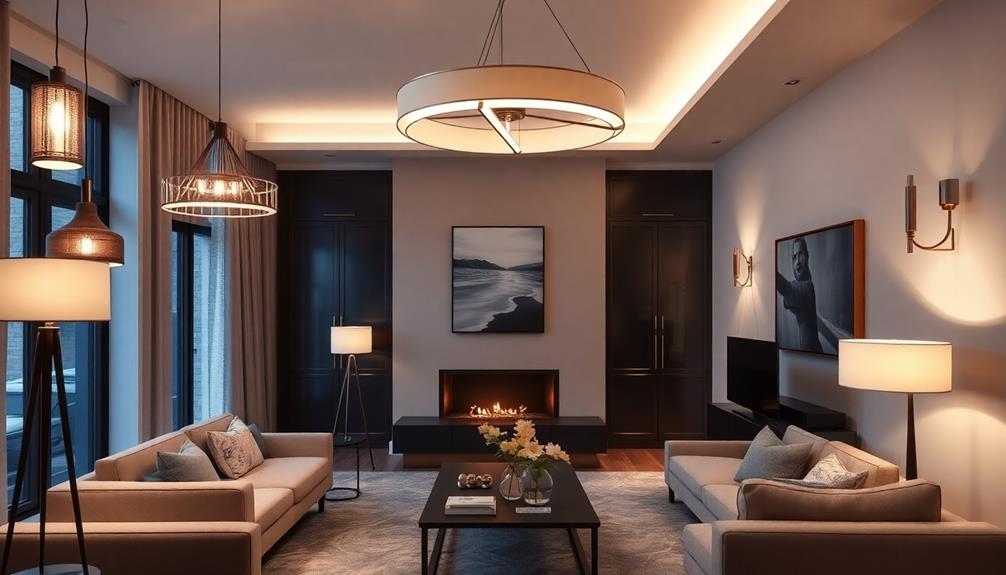
When you're looking for lighting that complements your decor, consider the design philosophies of leading brands like Louis Poulsen and Mater.
Each brand offers unique products that not only elevate your space but also align with sustainable practices.
To further enhance your interior, think about incorporating elements from the Balinese furniture market, which emphasizes sustainable craftsmanship.
Brand Design Philosophy
Leading lighting brands have unique design philosophies that reflect their commitment to quality and aesthetics. For instance, Louis Poulsen creates timeless designs that seamlessly blend functionality with elegance, enhancing architectural features with their outdoor lighting solutions. If you want to draw attention to specific areas in your space, their products can be a great choice.
Additionally, brands like Mahallati Interiors focus on integrating natural elements into their designs, which can also influence your choice of lighting to create a harmonious atmosphere.
On the other hand, Mater stands out with its eco-friendly philosophy, marrying stylish aesthetics with sustainable materials. This brand emphasizes ethical consumption while providing functional pieces that elevate your interior lighting.
Similarly, GUS Modern offers distinctive lighting that incorporates clean lines and innovative designs, catering to a contemporary aesthetic that can transform any room.
Many leading lighting brands prioritize a balance of design, functionality, and longevity. You'll find that they often provide customizable options, letting you mix and match elements to create a personalized look.
This flexibility guarantees that the lighting not only serves its purpose but also complements your overall decor style, making your space feel cohesive and inviting. Embracing these philosophies can help you choose lighting that truly enhances your interior design.
Unique Product Offerings
Exploring unique product offerings from top lighting brands reveals a wealth of options tailored to enhance your space.
These brands combine functionality, design, and style, ensuring you find the perfect lighting for your interior decor. Additionally, taking into account the energy efficiency of LED lights can greatly reduce operational costs while providing the right ambiance.
Here are four standout brands to take into account:
- Louis Poulsen: Known for exquisite outdoor lighting, this brand merges functionality with artistic elegance, ideal for enhancing your exterior spaces.
- Mater: Focusing on stylish, eco-friendly lighting solutions, Mater marries modern aesthetics with sustainability, appealing to those who prioritize environmentally conscious designs.
- GUS Modern: Offering unique, contemporary lighting options, GUS Modern provides statement pieces that deliver versatile illumination for various interior styles.
- Layered Lighting: Each of these brands emphasizes the importance of ambient, task, and accent lighting, allowing you to create a well-rounded lighting scheme that elevates your home decor.
Sustainability Practices
Sustainable practices are becoming increasingly important in the lighting industry, as brands recognize their role in reducing environmental impact. By choosing lighting solutions that prioritize sustainability, you contribute to a healthier planet while enhancing your interior decor.
Here's a quick overview of leading brands focusing on eco-friendly practices:
| Brand | Sustainability Focus |
|---|---|
| Mater | Eco-friendly materials and production methods |
| Louis Poulsen | Energy-efficient LED designs, reducing consumption by up to 80% |
| GUS Modern | Longevity in products to minimize waste |
| Custom Brands | Modular and customizable options for adaptability |
| Transparency | Ethical sourcing and responsible supply chains |
Opting for energy-efficient and eco-friendly lighting can greatly reduce your carbon footprint. Brands like Louis Poulsen utilize LED technology, while GUS Modern guarantees their fixtures last longer, minimizing replacements. With customizable and modular options available, you can adapt your lighting setup to fit your decor without constantly purchasing new fixtures. Additionally, many brands now embrace transparency, which adds an ethical dimension to your purchasing choices. Embrace sustainability in your lighting decisions for a stylish and responsible interior!
Effective Light Placement Strategies

When planning your lighting, think about layering light sources to create a dynamic atmosphere in your space.
Consider the room's function and strategically place fixtures to enhance both usability and style.
This approach not only brightens the area but also adds depth and interest to your decor.
Layering Light Sources
Layering light sources transforms a room from dim and lifeless to vibrant and inviting.
By combining ambient, task, and accent lighting, you create a balanced scheme that enhances both functionality and aesthetics. Incorporating elements like Indonesian decorative pillows can further elevate your decor by adding warmth and character.
Here's how to effectively layer your light sources:
- Start with Ambient Lighting: Install a ceiling-mounted fixture to provide overall illumination and set the room's mood.
- Add Task Lighting: Use floor or table lamps for specific activities like reading or cooking, ensuring these lights are bright enough for their purpose.
- Incorporate Accent Lighting: Highlight architectural features or artwork with strategically placed lights, drawing attention and adding visual interest.
- Utilize Dimmers: Install dimmers to adjust light intensity throughout the day, enhancing the versatility of your layered lighting scheme.
Room Function Considerations
Effective light placement strategies are key to enhancing the functionality of any room. Start by evaluating the primary activities within each space. For instance, in kitchens where cooking takes center stage, incorporate task lighting to illuminate work areas. In contrast, living rooms benefit from soft ambient lighting that promotes relaxation.
When it comes to the dining room, consider positioning accent lighting directly above the table. This creates a focal point that enriches the dining experience. In bedrooms, opt for calming ambient lighting combined with task lighting near bedside tables, allowing for comfortable reading without harsh brightness.
For entryways, employ strategic lighting placement to guarantee safe passage while making a welcoming impression. This can include a blend of ambient and accent lighting. If you're designing a multi-functional space, like a game room, spotlight features such as billiard tables with task lighting while maintaining sufficient ambient light for social interactions.
Here's a quick reference table for your lighting strategies:
| Room Type | Lighting Type | Purpose |
|---|---|---|
| Kitchen | Task Lighting | Illuminate work areas |
| Dining Room | Accent Lighting | Create a focal point |
| Living Room | Ambient Lighting | Promote relaxation |
Strategic Fixture Placement
To create a well-lit space, you should focus on strategic fixture placement that enhances both functionality and aesthetics. A well-planned lighting scheme utilizes a variety of lighting sources to achieve depth and warmth.
In traditional Indonesian homes, for instance, lighting often plays a role in enhancing the architectural features that reflect cultural significance, such as distinct architectural styles that vary by region.
Here are some effective strategies to contemplate:
- Layer your lighting: Combine ceiling lights with floor and table lamps to create multiple light sources. This layering enhances spatial perception and ambiance.
- Install wall sconces: Use wall sconces in narrow or awkward spaces to illuminate corners and recesses, adding depth and visual interest to your decor.
- Incorporate task lighting: Place focused lighting, like under-cabinet lights in kitchens or reading lamps in living areas, to support functionality while enhancing the overall aesthetic.
- Utilize accent lighting: Highlight architectural features or artwork with accent lighting, such as spotlights or picture lights, creating focal points that enrich the room.
Statement Lighting Choices

When it comes to making a bold impression in your interior decor, statement lighting choices play an essential role. Choosing a single large lamp as a statement piece can create a striking focal point in your room, drawing attention and enhancing overall design appeal.
Consider flamboyant lampshades that are patterned or uniquely shaped; they can serve as eye-catching accents, especially in minimalist spaces, adding character without overwhelming your decor. To further enhance your space, think about incorporating elements from coastal color palettes or natural materials, which can beautifully complement your lighting choices.
It's vital to balance the scale of statement lighting with other decor items. Large fixtures should complement your space while maintaining visual harmony with smaller elements. Oversized lighting can make a bold statement and fill vertical space, enhancing the sense of height in your room.
Using statement lamps strategically helps establish a unique design narrative, allowing you to express your personal style through thoughtfully chosen lighting fixtures. By integrating these elements into your decor, you create a cohesive look that not only illuminates your space but also tells a story, making your home feel distinctly yours.
Personalizing Your Lighting

Personalizing your lighting can transform your space into a true reflection of your style. By selecting the right fixtures and techniques, you can create an inviting atmosphere that resonates with your personality.
For instance, consider how traditional Indonesian style home decor often emphasizes natural materials and intricate designs, which can inspire your lighting choices.
Here are some key strategies for personalizing your lighting:
- Choose Unique Fixtures: Opt for bold statement lamps or elegant sconces that complement your decor, showcasing your taste.
- Incorporate Dimmers: Use dimmers to customize light intensity, allowing you to adjust the ambiance for various activities or moods.
- Highlight Personal Features: Utilize accent lighting to spotlight artwork or family photos, enhancing the warmth of your space and making it feel like home.
- Ensure Cohesive Color Temperature: Aim for a cohesive color temperature around 2700K, which provides a consistent and inviting ambiance throughout your home.
Frequently Asked Questions
How to Use Light in Interior Design?
To use light in interior design, you'll want to mix ambient, task, and accent lighting. Adjust bulb color temperatures, use dimmers, and place fixtures strategically to enhance the space's functionality and visual appeal.
How to Use Lighting Design to Transform Your Home?
To transform your home with lighting design, explore creative combinations of ambient, task, and accent lighting. Experiment with placement, brightness, and unique fixtures, allowing each element to evoke mood and enhance your space's functionality.
What Lighting Makes a House Look Expensive?
To make your house look expensive, choose statement fixtures like oversized chandeliers, use warm white light for a cozy vibe, and layer different lighting types to create depth and sophistication throughout your space.
How Can I Make My Room Beautiful With Lights?
To make your room beautiful with lights, mix ambient, task, and accent lighting. Use warm tones for coziness, bold fixtures as focal points, and strategically place highlights to create depth and enhance your overall decor.
Conclusion
Incorporating the right lighting can truly transform your space, creating ambiance and highlighting your decor's best features. Think of lighting as the brush that paints your room's personality. By understanding different types and placements, you can craft an inviting atmosphere that reflects your style. Remember, it's not just about illumination—it's about creating a mood. So go ahead and experiment with statement pieces and soft glows, and watch how your interior decor comes alive!
Home Decor
How Batik Symbolism Can Create Harmony and Balance in Your Home
See how Batik symbolism can enhance your home’s harmony and balance, and discover which patterns might resonate with your personal space.

Batik symbolism can transform your home by infusing it with deep meaning and a sense of balance. You can use patterns like the Kawung, which promotes serenity, or the Ceplok, fostering unity and emotional warmth. Incorporating Batik textiles in your decor—like cushions, wall art, or tablecloths—creates a harmonious atmosphere that enhances visual appeal. These vibrant designs not only beautify your space but also serve as cultural reminders that inspire conversation. By strategically placing Batik pieces, you actively cultivate a nurturing environment. Want to explore how to harmonize your home even further? You might find more valuable insights waiting for you.
Key Takeaways
- Batik motifs like Kawung and Ceplok symbolize balance and unity, fostering a serene and harmonious atmosphere in your home.
- Incorporating Batik textiles in decor, such as curtains and pillow covers, enhances warmth and visual balance, enriching your living spaces.
- Unique Batik patterns tell cultural stories, promoting discussions and adding depth to your home environment while reflecting values of harmony and balance.
- Strategic placement of vibrant Batik pieces can transform the ambiance, inviting positive energy and a sense of nurturing throughout the home.
- Batik art enhances aesthetics, merging traditional craftsmanship with modern design, resulting in a cohesive and inviting living environment.
The Essence of Batik Symbolism

Batik symbolism is more than just beautiful patterns; it's a way to infuse your home with meaning and harmony. By incorporating Batik motifs like the Kawung, you invite balance into your living space. This particular design symbolizes equilibrium, promoting a serene atmosphere that enhances your home decor.
Similarly, the Ceplok pattern represents unity and interconnectedness, reflecting the bonds of family and community. Using this motif can elevate the emotional ambiance of your interior design, creating a sense of togetherness. Additionally, the vibrant colors and intricate patterns found in Indonesian decorative pillows can complement Batik textiles wonderfully, further enriching your home.
Batik's Cakar Ayam design signifies diligence and prosperity, introducing positive energy flow that contributes to a harmonious home environment. When you choose Batik textiles, such as curtains or cushion covers, you're not just adding aesthetic appeal; you're also tapping into rich cultural traditions that foster tranquility.
Furthermore, incorporating Batik art pieces serves as a conversation starter and a reminder of the values of harmony and balance inherent in this tradition. By thoughtfully integrating these symbols into your home, you can create a space that resonates with peace and cultural depth, making your living area not just beautiful, but meaningful.
Historical Background of Batik
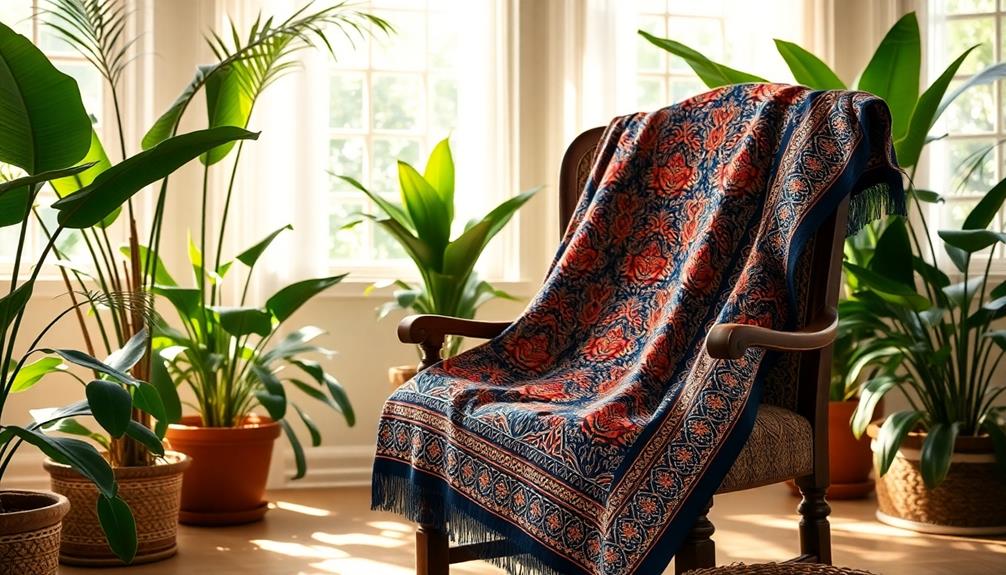
The rich cultural significance of Batik is deeply rooted in its historical background, which traces back to the Indonesian island of Java. This ancient textile art form originated as early as the 4th or 5th century AD, showcasing the skillful use of the wax-resist dyeing process.
The term "batik" derives from a Javanese word meaning "to dot" or "to stipple," reflecting the intricate patterns that characterize this craft. Batik, much like the intricate designs of Indonesian decor masks, holds a special place in Indonesia's cultural heritage, and its motifs often convey deeper meanings tied to traditions and beliefs.
In 2009, UNESCO recognized Batik as a Masterpiece of Oral and Intangible Heritage, highlighting its global importance.
Here are some key aspects of Batik's historical significance:
- Cultural Traditions: Specific designs are reserved for holidays and ceremonies.
- Symbol of Nobility: Certain patterns signify social status and nobility.
- Generational Legacy: The art has evolved through family traditions, showcasing vibrant cultural heritage.
Key Batik Patterns and Their Meanings

When decorating your home, incorporating key Batik patterns can greatly enhance the ambiance and meaning of your space. Each pattern carries unique symbolism that can foster harmony and balance in your environment.
The Kawung pattern, with its interlocking circles or squares, symbolizes balance and harmony, making it ideal for evoking tranquility. Additionally, integrating traditional art elements, such as Indonesian decor masks, can further enrich the cultural storytelling in your home, adding depth to your decor traditional artistry in masks.
The Ceplok pattern features bold central motifs that embody unity and adaptability, perfect for creating a cohesive aesthetic in your living areas.
Meanwhile, the Nitik pattern, with its tiny dots arranged in geometric designs, represents fertility and growth, encouraging positive energy and an uplifting atmosphere.
If you're looking for strength, consider the Parang pattern, characterized by diagonal lines that symbolize power and resilience, instilling stability within your home.
Incorporating Batik in Home Decor

Integrating Batik into your home decor not only enhances visual appeal but also brings rich cultural significance to your space. You can easily incorporate batik motifs and vibrant colors into various elements of your home, creating an inviting atmosphere that reflects traditional artistry.
Additionally, the intricate designs of Indonesian decor masks can complement batik pieces, further enriching your home's aesthetic.
- Batik fabric for curtains and pillow covers: These pieces add warmth and intricate patterns, elevating your living space.
- Batik tablecloths or runners: They create a unique dining experience, infusing meals with cultural richness while promoting harmony and prosperity among family members.
- Batik-inspired wall art: Framed pieces or canvas prints act as eye-catching focal points, celebrating heritage and enhancing the overall decor.
Creating Balance With Batik Textiles
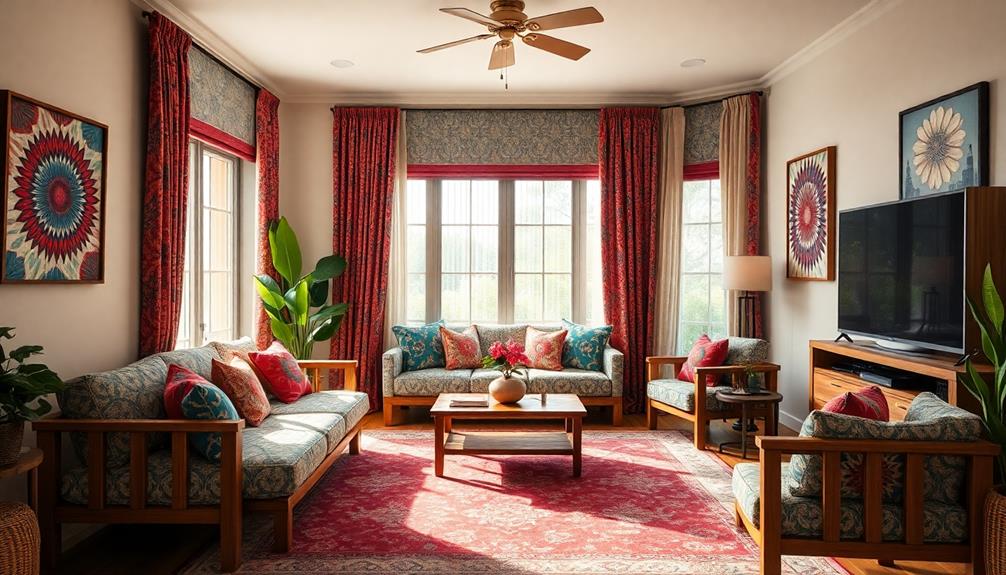
Batik textiles offer a unique way to bring harmony and balance into your home. By incorporating these stunning fabrics, you can create an inviting ambiance that resonates with unity and stability. Geometric patterns like the Kawung design symbolize balance, while motifs such as the Ceplok pattern enhance feelings of calm in shared spaces.
Here's a quick overview of how different batik designs can impact your decor:
| Design | Symbolism | Effect on Space |
|---|---|---|
| Kawung | Harmony | Serene atmosphere |
| Ceplok | Stability | Enhanced unity and calm |
| Mega Mendung | Life-giving rains | Revitalizing and nurturing ambiance |
| Vibrant Colors | Cultural artistry | Infuses positive energy |
| Geometric Patterns | Visual balance | Cohesive decor aesthetic |
Utilizing vibrant batik colors and designs in items like curtains or pillow covers can infuse your environment with cultural artistry. Strategically placing these batik pieces throughout your home cultivates a visually balanced aesthetic, allowing you to enjoy the intricate stories and meanings behind each design. Embrace the beauty of batik textiles to enhance your space's harmony and stability.
Batik as Cultural Storytelling

Incorporating batik textiles into your home isn't just about aesthetics; it's a way to weave cultural narratives into your living space.
Batik patterns serve as a medium for storytelling, reflecting deep cultural heritage and societal values. Each design conveys themes of harmony and balance, enriching your environment with symbolic meanings.
Additionally, using natural materials in conjunction with batik can enhance the overall ambiance, creating a space that resonates with traditional Indonesian style.
Consider these impactful batik motifs:
- Kawung pattern: Featuring interlocking circles, it symbolizes the eternal cycle of life and hope for enduring balance.
- Nitik pattern: Representing fertility and growth, it inspires a nurturing atmosphere, enhancing family harmony.
- Ceplok pattern: With its geometrical shapes, it embodies the essence of unity, resonating with togetherness in your home decor.
Harmonizing Spaces With Color
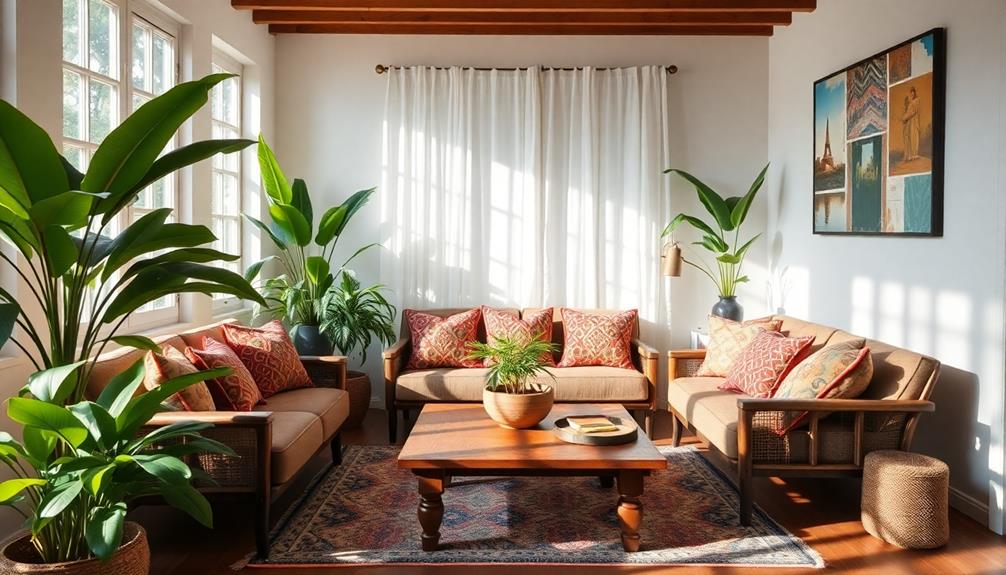
Harmonizing your living space with color can transform the atmosphere and evoke a sense of warmth and positivity. By incorporating batik fabric into your home decor, you enhance the color palette while embracing intricate patterns that invite balance and harmony. The Kawung pattern, with its interlocking circles, symbolizes unity, making it perfect for cushions or wall hangings.
To visualize how colors and patterns can work together, consider this layout:
| Batik Motif | Color Palette | Decorative Element |
|---|---|---|
| Kawung | Earthy tones | Cushion covers |
| Mega Mendung | Blues and greens | Tablecloth |
| Floral patterns | Warm vibrant hues | Curtains |
Using batik-inspired curtains or tablecloths creates focal points that not only showcase unique designs but also stir conversations. The Mega Mendung pattern represents life-giving rains, instilling tranquility and a connection to nature. By integrating batik motifs into your decor, you embrace a rich cultural heritage that resonates with values of unity and balance, fostering a harmonious atmosphere throughout your home.
Modern Applications of Batik
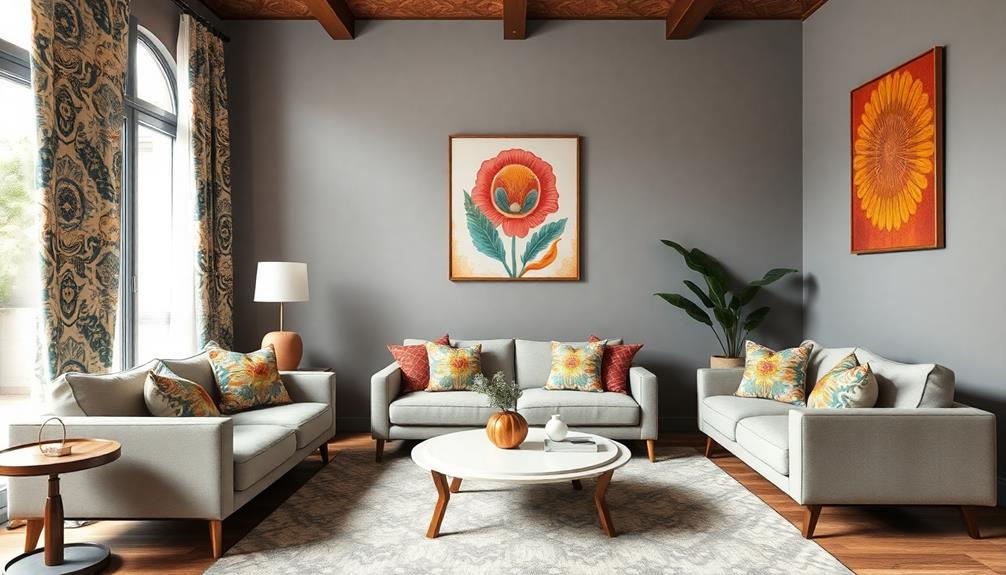
Home decor can effortlessly blend tradition with modernity when you embrace batik's vibrant patterns and colors. By incorporating batik fabric into your living space, you invite a touch of cultural artistry that enhances the overall aesthetic.
These traditional patterns can transform ordinary items into stunning focal points, creating a warm and harmonious atmosphere. Additionally, the use of natural materials and sustainable practices in designs, similar to luxury tropical design aesthetics, aligns beautifully with the ethos of batik artistry.
Consider these modern applications of batik:
- Batik quilts: Serve as both functional items and artistic statement pieces, showcasing unique designs and textures.
- Upholstery: Contemporary designers are using batik for furniture upholstery, merging traditional craftsmanship with modern design elements for a stylish finish.
- Wall art: Batik can also be used creatively in wall art, providing an eye-catching blend of color and cultural heritage.
The versatility of batik allows you to explore various creative projects, from curtains and pillow covers to tablecloths. Each piece not only adds beauty but also honors the rich traditions behind this exquisite fabric.
Frequently Asked Questions
What Does Batik Symbolize?
Batik symbolizes cultural heritage and identity. Each pattern conveys unique meanings, like strength, harmony, and divine blessings. By understanding these symbols, you can appreciate their significance and enhance your living space's character and ambiance.
How Is Batik Used in Everyday Life?
How do you express your culture daily? You use batik in your clothing, home decor, and accessories, embracing its vibrant patterns and rich heritage, transforming ordinary spaces into reflections of your identity and creativity.
What Is the Importance of Batik?
Batik's importance lies in its rich cultural significance and storytelling. You appreciate its intricate designs that reflect heritage and philosophy, connecting you to a broader community while enhancing your living space with beauty and meaning.
What Makes Batik Special?
Batik's special because it blends intricate artistry with deep cultural meanings. Each design you see tells a story, reflecting values like balance and strength. You'll appreciate its vibrant colors and rich heritage adorning your space.
Conclusion
By embracing batik symbolism in your home, you're not just decorating; you're infusing your space with rich cultural narratives and meaningful patterns. You might think it's too bold for your decor style, but batik's versatility allows it to blend beautifully with various aesthetics. Whether you choose vibrant colors or subtle hues, batik can create harmony and balance, turning your home into a sanctuary that reflects both your personality and a deep appreciation for artistic heritage.
Home Decor
Discover the Batik Patterns That Will Add Depth to Any Space
Open your eyes to the vibrant world of batik patterns that can transform your space into a masterpiece—discover the possibilities that await!
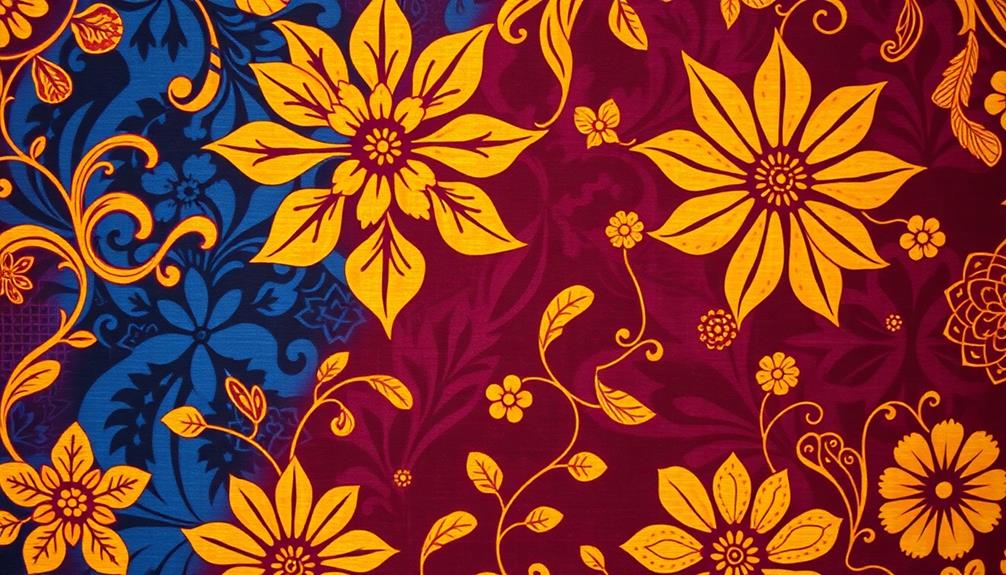
Batik patterns are a fantastic way to infuse vibrancy and depth into your space. Originating from Javanese culture, these intricate designs feature rich colors and unique motifs, each with its significance. You'll find styles like Batik Tulis, hand-drawn for a personal touch, or Batik Cap, stamped for ease. Whether you choose decorative cushions, bold wall art, or vibrant table runners, batik adds character and a sense of history to your decor. This creative flexibility complements various design styles while offering a unique, artistic flair. Stick around to explore even more stylish batik options that can transform your home!
Key Takeaways
- Batik patterns, rooted in Javanese culture, showcase intricate artistry that adds historical richness to any decor.
- Vibrant designs, such as the Color Flow and Juxtaposition quilts, create stunning visual contrasts in living spaces.
- Unique, handmade batik pieces serve as focal points, enhancing artistic expression and personalization in interior design.
- Seasonal batik patterns, like Snow Crystals, introduce festive themes while showcasing craftsmanship, perfect for holiday decor.
- Incorporating batik textiles elevates home decor, providing a personal touch and fostering cultural appreciation in various settings.
Understanding Batik Patterns

When you immerse yourself in the world of batik patterns, you uncover a rich tapestry of artistry and culture. Traditional batik originated from the Javanese tradition, where artisans employ intricate batik techniques to create stunning designs. This craft involves applying hot wax onto fabric, which resists dye, resulting in vibrant, unique patterns that tell stories through their motifs.
Additionally, batik patterns often share similarities with traditional Indonesian decor masks, as both celebrate the rich cultural heritage of Indonesia through vibrant artistry and storytelling traditional artistry.
You'll find different types of batik, such as Batik Tulis, which is hand-drawn, and Batik Cap, which is stamped. Each method offers varying levels of detail, showcasing the skill of the maker. The batik motifs you encounter often carry significant cultural meanings; for instance, certain colors and designs can denote social status or convey specific messages within Indonesian culture.
When you consider incorporating batik into your home decor or fashion choices, you're not just adding beauty; you're also embracing a piece of history. The versatility of batik allows it to enhance any space, blending historical richness with modern artistic expression.
Seaside and Coastal Inspirations

Batik patterns inspired by the seaside can transform your space into a tranquil coastal retreat. Imagine the soothing blues and greens reminiscent of ocean waves dancing across your walls or furniture.
Incorporating Indonesian Decorative Pillows with vibrant batik designs can further enhance the coastal vibe, adding comfort and cultural heritage to your decor. Batik fabrics featuring designs like the Seaside Steps quilt, with its Courthouse Steps blocks in fresh, cool tones, evoke that nautical feel perfect for coastal decor.
Another stunning option is the Batak Ocean Waves quilt, which incorporates gold triangles that create playful pinwheels within the Ocean Waves blocks. The combination of blue and cream batiks adds a sense of movement, making your space feel alive and inviting.
For a more modern touch, the Beachy Waves quilt showcases a bargello style that mimics actual ocean waves, using a palette of sea glass colors. This creates a soothing ambiance ideal for beach houses or any coastal-inspired room.
All these batik designs not only celebrate the beauty of traditional motifs but also bring a revitalizing atmosphere into your living spaces.
Plus, they're available as free downloads, allowing you to easily enhance your home decor with seaside charm.
Seasonal and Holiday Themes

Celebration comes alive with seasonal and holiday-themed batik patterns that bring joy and warmth to any space. These patterns, like Snow Crystals, capture the essence of winter with cool colors, perfect for seasonal decor and striking wall hangings. The Patriotic Patches pattern features vibrant red squares alongside serene blue and white strips, making it an ideal choice for patriotic celebrations.
Incorporating seasonal batik designs into your home not only adds a festive touch but also showcases the unique artistry and craftsmanship of batik textiles. Many seasonal batik quilts come with free patterns available for download, allowing you to easily integrate these stunning designs into your holiday decor.
| Pattern Name | Best For |
|---|---|
| Snow Crystals | Winter decor |
| Patriotic Patches | Independence Day |
| Seasonal Quilts | Year-round celebrations |
Using batik fabrics enhances the visual appeal, creating a vibrant atmosphere during celebrations. Whether you're hosting a gathering or simply want to add a touch of warmth, these seasonal batik patterns are sure to make your space feel festive and inviting.
Vibrant and Colorful Designs
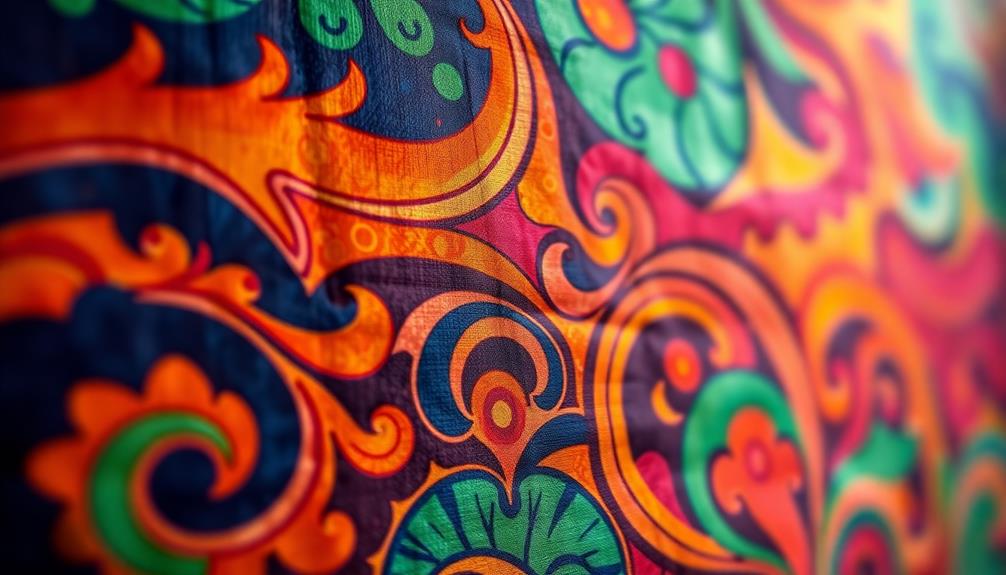
Amidst the world of interior design, vibrant and colorful batik patterns effortlessly alter any space into a visual feast. You'll find that traditional Indonesian batik, with its rich history, showcases vibrant designs that breathe life into your home.
Consider the Juxtaposition quilt, featuring jewel tones that create stunning contrasts, perfect for cozy settings. Or take a look at Color Flow, which presents an enchanting rainbow effect, shifting from hot to cool colors set against a bold black background—ideal for striking wall decor. These batik patterns, much like the unique artistic expressions found in Indonesian decor masks, highlight the beauty of traditional craftsmanship.
The Batik Jewels Throw offers large triangle-square units in elegant jewel tones, creating a diagonal-stripe effect that enhances any living space. Each of these vibrant designs not only highlights the intricate craftsmanship of batik textile art but also invites you to explore your creativity.
Free quilt patterns are available for download, making it easier than ever to incorporate these modern motifs into your decor.
With these colorful batik patterns, your space will reflect both style and personality, turning it into a warm and inviting haven that celebrates the beauty of batik.
Unique and Artistic Patterns
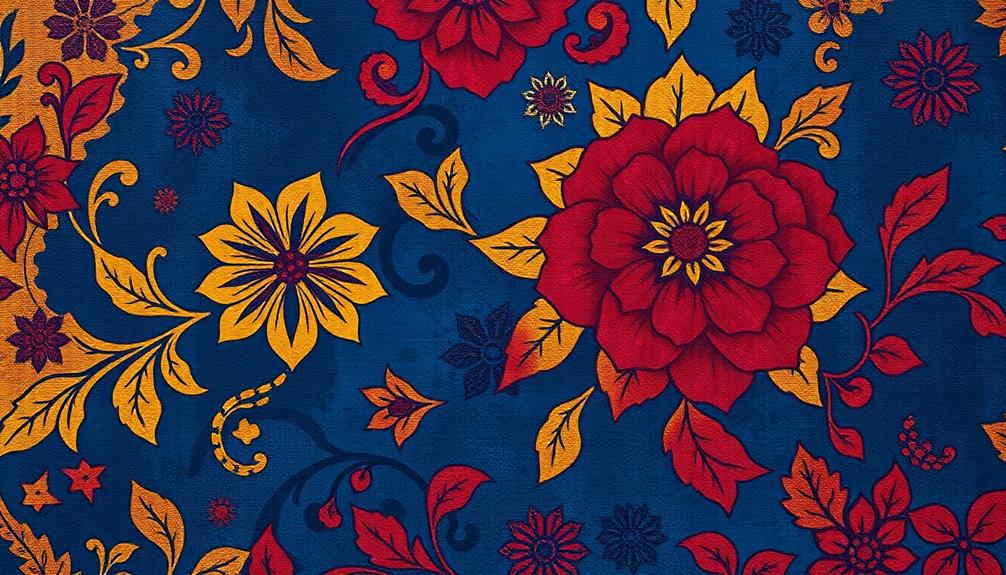
When you explore unique batik patterns, you'll discover a world of artistic expression waiting to be released. Each design, inspired by various themes and styles, invites you to interpret and personalize it in your own way.
These patterns not only enhance the aesthetic appeal of your space but also reflect the rich cultural heritage of Indonesia, much like the intricately designed Indonesian decor masks that tell stories through their craftsmanship.
Whether it's the intricate Tile Style or the subtle Wild Triangle-Squares, these patterns transform any space into a creative haven.
Artistic Expression in Batik
Batik patterns offer a vibrant canvas for artistic expression, inviting you to explore unique designs that transform any space. You can experience the beauty of batik cloth through various batik creations, each reflecting the intricate techniques of ancient Javanese artistry.
Incorporating batik into your decor aligns beautifully with traditional Indonesian style home decor, emphasizing harmony with nature and showcasing local culture. Using batik allows you to showcase your creativity, whether through a complex batik throw inspired by tiled auditorium floors or a subtle Wild Triangle-Squares wall hanging that captures a unique watercolor effect.
The Batik Jewels Throw demonstrates elegance with large triangle-square units that create a striking diagonal-stripe effect, perfect for cozy living areas. Each hand-drawn batik piece emphasizes vibrant colors and detailed patterns, encouraging you to express your artistry and elevate your decor.
The intricate wax-resist dyeing techniques contribute to the uniqueness of each pattern, making them ideal for those seeking depth and character.
Unique Design Inspirations
Adding batik to your decor opens up a world of unique design inspirations that can elevate your space. Consider the Tile Style batik throw, inspired by tiled auditorium floors, which showcases intricate patterns and encourages your artistic expression. This piece, with its complex designs, can be an eye-catching addition to your living room or bedroom, creating a stunning batik wall.
Additionally, incorporating traditional motifs and patterns can enhance the cultural significance of your decor.
For those drawn to nature, the Wild Triangle-Squares Wall Hanging offers a safari theme with subtle, watercolor effects. The limited contrast in batiks allows the rich dark blue hues to blend beautifully, making it perfect for a serene and inviting atmosphere.
Both of these unique batik designs not only serve as focal points but also enhance the visual appeal of your interiors. The batik industry produces an array of options, from vibrant silk batik to more muted pieces, allowing you to find the perfect match for your style.
Incorporating Batik in Home Decor

Transforming your home into a vibrant sanctuary can be easily achieved through the incorporation of batik fabrics. These textiles, renowned for their intricate designs and vibrant colors, can elevate your home decor in various ways.
Batik's unique patterns can complement the calming earth tones and natural materials often seen in Balinese interior design concepts. You can effortlessly incorporate batik, whether it's Batik Tulis or stamped batik, to create a unique artistic atmosphere.
Here are some creative ideas for using batik in your space:
- Cushions and Throws: Add colorful batik cushions and throws to your living room for an instant pop of color.
- Wall Art: Hang framed batik panels as bold statement pieces that reflect cultural significance and craftsmanship.
- Table Runners: Use batik table runners or placemats to enhance your dining experience, bringing warmth and style to your meals.
The versatility of batik allows it to blend seamlessly into various design styles, from traditional to modern.
Plus, the handmade nature of these fabrics guarantees that each piece is unique, giving your home decor an authentic and personal touch that mass-produced items simply can't match.
Embrace batik and watch your space come alive!
Frequently Asked Questions
What Are the Patterns of Batik?
Batik patterns vary widely, including intricate hand-drawn designs, stamped motifs, and painted styles. Each offers unique artistic expressions, reflecting cultural significance and vibrant colors influenced by regional traditions and modern interpretations. You'll appreciate their beauty!
What Are the 5 Major Types of Batik Design?
When exploring batik designs, you'll encounter five major types: Batik Tulis, Batik Cap, Batik Lukis, Batik Pesisir, and Batik Belanda. Each offers unique techniques and styles, showcasing Indonesia's rich cultural heritage and artistic expressions.
What Is the Most Famous Batik Pattern?
Did you know that the "Kawung" pattern is one of the most famous batik designs? Its geometric coconut symbol holds deep cultural significance in Javanese society, representing both beauty and tradition. You'll love its intricate elegance!
What Are the Three Main Elements of Batik Pattern?
The three main elements of batik patterns are the base fabric, wax application, and dye baths. You'll see how these components work together to create vibrant, intricate designs that reflect cultural significance and artistic expression.
Conclusion
Incorporating batik patterns into your home decor is like adding a splash of color to a black-and-white canvas. These vibrant designs can transform any space, imbuing it with personality and warmth. Whether you opt for seaside motifs, seasonal themes, or unique artistic prints, you'll create an inviting atmosphere that reflects your style. So go ahead, embrace the beauty of batik and watch your home come alive with depth and character!
Home Decor
Batik: The Cultural Design Element You’re Missing in Your Home
Not only does Batik enhance your home decor, but it also connects you to a rich cultural narrative waiting to be explored.

Batik isn't just a beautiful textile; it's a piece of rich cultural heritage you're missing in your home. Originating from Indonesia, Batik features vibrant colors and intricate patterns that tell stories of history and symbolism. By incorporating items like cushion covers or wall art, you add depth and character to your space. The Phoenix motif, for instance, represents interdependence, while other designs reflect themes of regeneration and environmental balance. Plus, using Batik supports local artisans and sustainable practices. Want to discover how to seamlessly integrate these stunning designs into your decor? There's so much more waiting for you.
Key Takeaways
- Batik textiles feature vibrant colors and intricate patterns, adding a unique cultural touch to your home decor.
- Incorporating Batik items like cushion covers and wall hangings creates a narrative that reflects Indonesian heritage.
- Each Batik motif carries rich symbolism, offering deeper meaning beyond mere decoration in your living space.
- Supporting local artisans through Batik promotes sustainable practices in the textile industry while celebrating artistic expression.
- Modern Batik designs blend traditional artistry with contemporary aesthetics, appealing to diverse home decor styles.
Historical Significance of Batik

Batik, with its roots deeply embedded in Indonesia's rich history, stands as not just a textile art but a symbol of cultural identity. The historical significance of Batik is profound, tracing back to the Hindu-Buddhist Majapahit Empire, where it first flourished. This traditional Javanese art form evolved during the 16th century, integrating Islamic influences and showcasing the diverse cultural heritage of Indonesia.
Similar to traditional artistry in Indonesian decor masks, Batik textiles reflect the vibrancy and complexity of local stories and customs.
As you explore Batik, you'll notice how its textiles reflect various historical intersections, blending motifs from Hindu, Buddhist, Chinese, Arab, European, Japanese, and even African cultures. Each pattern tells a story, serving as a historical record that captures the essence of Indonesian life and traditions.
The shift from natural plant dyes to synthetic dyes in the 1800s marked a significant evolution, broadening the color palette available for artisans and enhancing the durability of these intricate designs.
Batik isn't just decorative; it symbolizes philosophical beliefs and social status, playing an essential role in formal occasions and daily wear across Indonesian society.
Through its rich history, Batik remains a reflection of the enduring cultural identity of the Indonesian people.
Understanding Batik Motifs
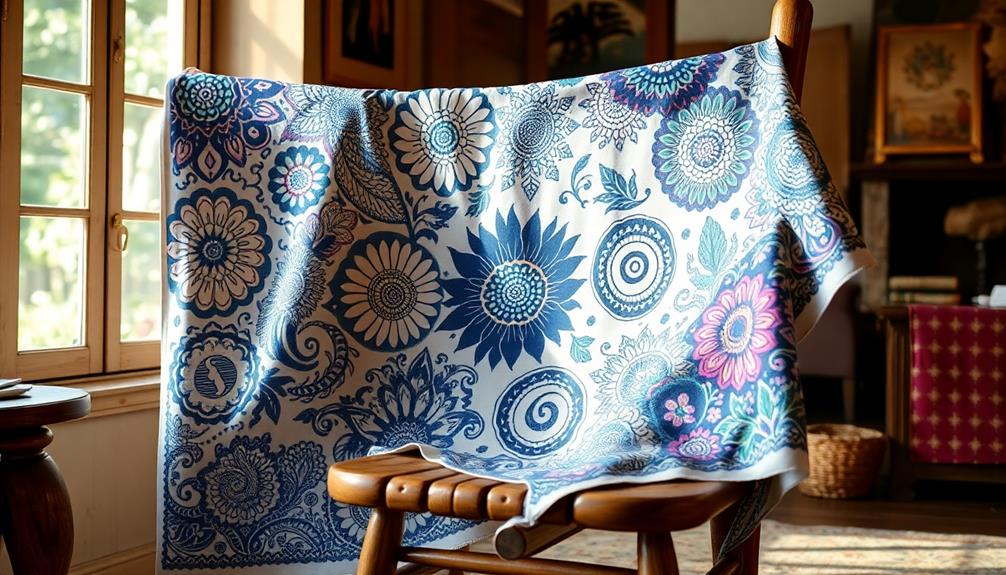
The intricate world of Batik motifs offers a fascinating glimpse into Indonesia's cultural tapestry, where each design serves a purpose beyond mere decoration. Understanding Batik means appreciating the rich symbolism woven into every pattern.
For instance, the Javanese Batik design of the Phoenix Lung-lungan represents interdependence and mutual support, reflecting deep social values. The Kawung motif, with its intersecting squares and circles, historically signified prestige, reserved for royalty, illustrating the cultural hierarchy in Javanese society. Additionally, many Batik patterns, much like the Indonesian decor masks, showcase intricate designs that celebrate traditional craftsmanship.
Furthermore, non-geometric patterns often symbolize regeneration and fertility, showcasing diverse flora and fauna that carry spiritual significance. These motifs connect the wearer to their cultural heritage, transforming them from simple decorative elements into powerful narrative tools.
Take the Udan Liris motif, translating to "light rain," which features diagonal rows of narrow bands symbolizing natural phenomena. This highlights how Batik art can reflect environmental themes as well.
Batik Production Techniques

Understanding the artistry behind Batik motifs naturally leads to exploring the various production techniques that bring these designs to life. The three main Batik production techniques are Batik Tulis, Batik Cap, and Batik Cetak. Each method showcases the cultural heritage of Batik while varying in quality and artistic value.
| Technique | Description |
|---|---|
| Batik Tulis | Hand-drawn designs using a canting tool and wax, allowing for intricate designs that can take months. |
| Batik Cap | Utilizes copper stamps for quicker wax application, maintaining artistic value with efficient production. |
| Batik Cetak | Printed textiles that are more accessible but sacrifice some traditional craftsmanship. |
| Natural Dyes | Traditionally derived from plants like Indigofera and Soga tree, offering rich, vibrant colors. |
While Batik Tulis is often regarded as the highest quality due to the skill involved, Batik Cap and Batik Cetak offer their own unique appeal. Embracing these Batik production techniques not only enhances your home decor but also celebrates the intricate designs and artistic value that reflect a rich cultural heritage.
Modern Interpretations of Batik
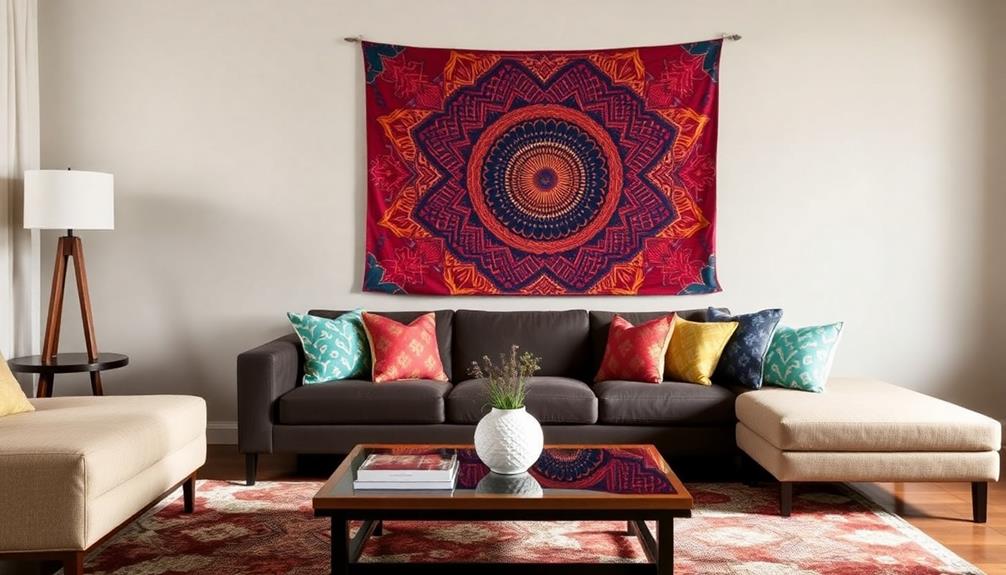
Modern interpretations of Batik have emerged as a vibrant blend of traditional artistry and contemporary design, capturing the attention of a global audience. Designers are now embracing modern Batik by infusing contemporary batik elements with traditional artistic techniques, appealing to younger consumers.
This fusion of traditional patterns and modern aesthetics enhances the visibility of Batik textiles in the home decor market, making it a popular choice for items like Indonesian decorative pillows, which add comfort and cultural heritage to living spaces.
Through innovative ways, designers are expanding Batik's application beyond clothing, incorporating it into accessories and interior decor. Digital printing technology allows for rapid production, enabling designers to experiment with batik designs and customize them to meet diverse consumer preferences.
As a result, unique collections resonate with current fashion trends while preserving the cultural significance of this ancient art form.
Collaborations between artisans and modern designers have also emerged, creating collections that tell contemporary stories and reflect societal values, all while honoring Batik's rich heritage.
Incorporating Batik in Home Decor

Incorporating Batik into your home decor not only highlights vibrant colors and intricate patterns but also connects your space to the rich cultural heritage of Indonesia. The unique artistry of Batik textiles complements other cultural elements, such as Indonesian decor masks, allowing for a cohesive and meaningful decor theme.
You can easily transform your environment by using Batik textiles in various decor items like cushion covers, table runners, and wall hangings. These pieces serve as visually appealing elements that blend traditional motifs with modern aesthetics, making them perfect conversation starters.
By choosing Batik, you support local artisans and promote sustainable practices within the textile industry. Each design often carries nature symbolism, contributing to a calming atmosphere that enriches your home.
Integrating Batik elements, such as curtains or upholstery, allows you to embrace the storytelling aspect of decor, as each piece reflects unique narratives tied to Indonesian heritage.
Whether you opt for bold patterns or subtle designs, Batik can enhance your home decor while celebrating cultural significance. You'll not only enjoy the beauty of these intricate patterns but also appreciate the deeper meanings behind them, connecting your living space to a rich history and artistic expression.
Frequently Asked Questions
What Are the Elements of Batik Design?
Batik design elements include intricate motifs, natural themes, and symbolic colors. You'll notice patterns like the Kawung and Udan Liris, each representing deeper meanings rooted in culture, spirituality, and social values throughout Indonesia's rich artistic heritage.
What Is the Cultural Significance of Batik?
Batik's cultural significance is like an intricate tapestry, weaving together Indonesia's rich history and diverse identities. Each motif you see tells a story, reflecting community ties, social status, and natural beauty, enriching your understanding of its heritage.
What Are the 5 Major Types of Batik Design Motif?
You'll find five major batik motifs: Ceplok with geometric shapes, Udan Liris symbolizing rain, Kawung representing prestige, Tambal Miring reflecting Buddhist influence, and Non-Geometric patterns showcasing nature's beauty and spiritual significance.
What Is Batik Design?
Batik design's a traditional Indonesian textile art, created using wax-resist dyeing techniques. You'll find intricate patterns that reflect cultural stories and values, showcasing themes like nature, spirituality, and social significance in every piece.
Conclusion
By now, you've discovered the rich history and vibrant motifs of batik, along with the intricate techniques that bring them to life. Imagine how these stunning designs could transform your space. Picture the warm embrace of colors and patterns that tell a story, inviting intrigue and conversation. As you consider incorporating batik into your home decor, ask yourself: which piece will you choose to make your environment uniquely yours? The perfect touch awaits—will you seize it?
-

 Mom3 months ago
Mom3 months agoHeartfelt Poems for Your Daughter’s Birthday
-

 Mom3 months ago
Mom3 months agoHappy Birthday Religious Wishes and Blessings
-

 Mom3 months ago
Mom3 months agoHappy 65th Birthday: Celebrate Your Special Day!
-

 Mom3 months ago
Mom3 months agoHappy Birthday in Heaven from Daughter: Remembering You
-

 Mom3 months ago
Mom3 months agoCelebrating 60 Years: Happy 60th Birthday Wishes
-

 Mom3 months ago
Mom3 months ago62nd Birthday Quotes for Mom: Celebrate Her Special Day
-

 Mom3 months ago
Mom3 months agoCelebrate a Joyous Happy 70th Birthday Milestone!
-

 Mom3 months ago
Mom3 months agoHappy 61st Birthday: Celebrate This Special Milestone



















